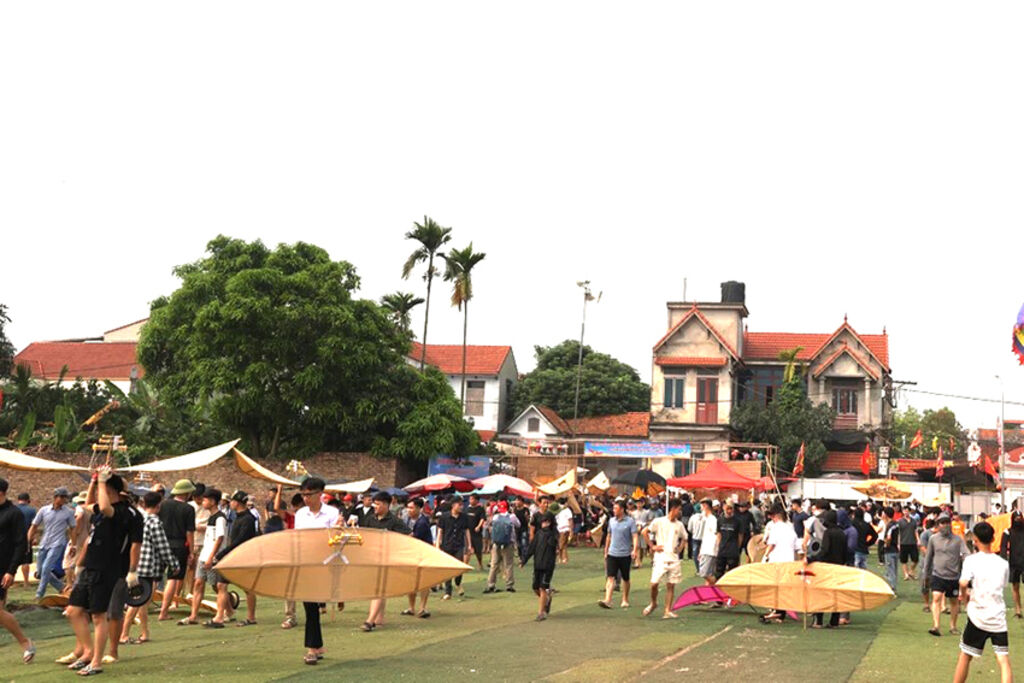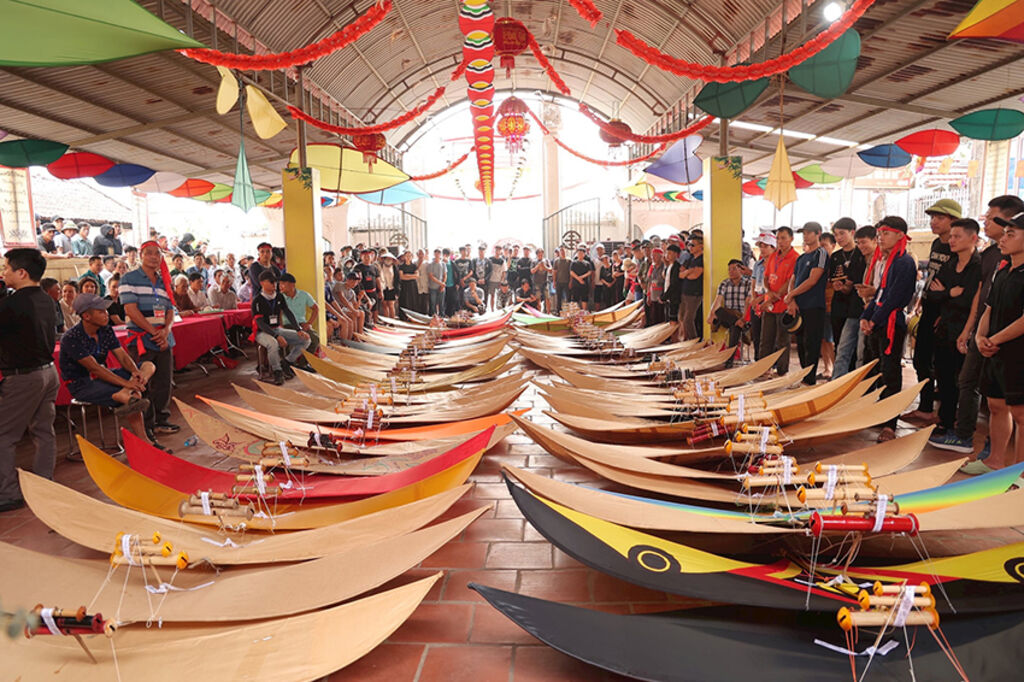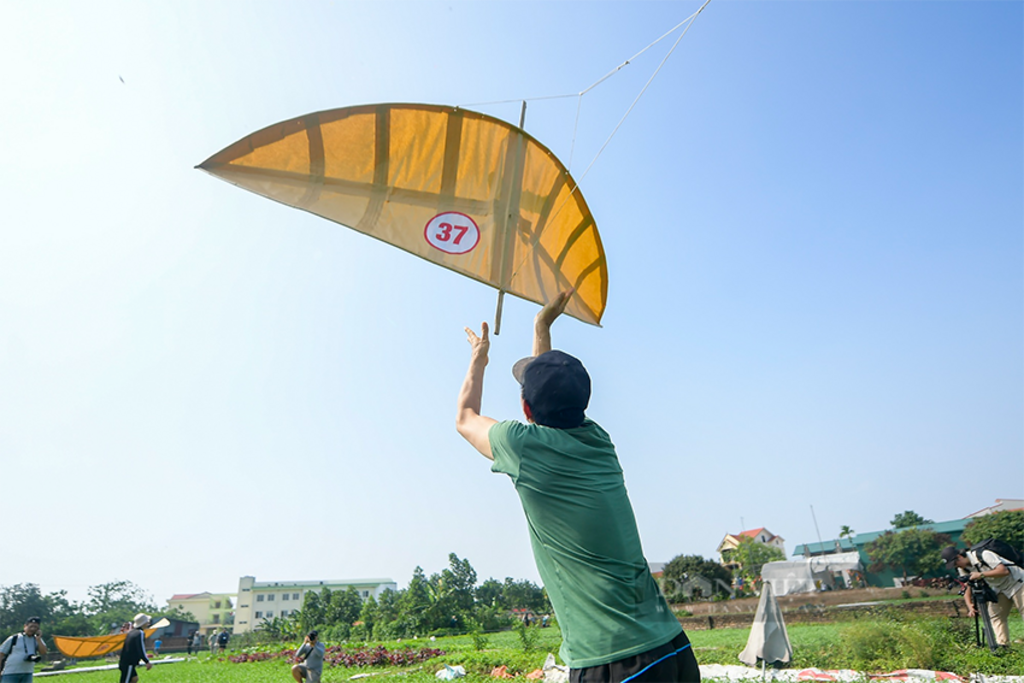 |
| Flying a kite during the kite festival in Ba Duong Noi village__Photo: VNA |
Kite flying is a popular childhood game in most Vietnamese rural areas but people in Ba Duong Noi village in Hanoi’s outskirt district of Dan Phuong have turned it into art.
Legend has it that kite flying hobby was passed on to Ba Duong Noi villagers by General Nguyen Ca, who lived in the reign of King Dinh Tien Hoang (968-980). After helping the King defeat rebellious warlords, he returned to his hometown and taught villagers rice cultivation and children how to make and fly bamboo kites. As time went by, the making of bamboo kites without tails but flutes has become a cultural tradition passed down for generations. Nowadays, on the 15th of the third lunar month, villagers hold an incense-offering ceremony in his temple to show their gratitude and respect to the ancestor of the traditional bamboo kite making craft, followed by a flute kite competition to choose a flute kite with the best performance of the year.
 |
| A flute ensemble usually consists of three flutes of different sizes__Photo: VNA |
True to its name, a flute kite consists of two parts: a kite and flutes. Making a flute kite by hand requires many complicated steps ranging from selection of bamboo for making frames and flutes to preparation of traditional materials for sails and kite lines.
September and October are considered the best time to harvest old bamboo trees because at that point of time, the weather is dry and bamboo stalks are sturdy and flexible. Once harvested, bamboo stalks are fumigated above stoves to enhance their termite resistance and durability. The bamboo stalk’s bottom section is usually used to make kite frames while the top section is used for flutes.
 |
| Flute kites ready for Ba Duong Noi flute kite competition 2024__Photo: Hong Ngoc/Vietnam+ |
Ba Duong Noi villagers usually use do (poonah) paper for kite sails. Poonah paper will be applied with a special substance, made by crushing and dissolving unripe date-plum fruits in water then filtering the mixture to obtain a thick liquid, so as to become waterproof and robust.
In the past, even kite lines used to be made from bamboo. Villagers often cut down young bamboo trees in late spring, when the weather is wet and humid, and then split the bamboo stalk into thin strips. These strips are then simmered in a mixture of salt and castor bean seeds for approximately eight hours before being joined together to form a long line. Bamboo kite lines made by this traditional method are lightweight, pliable and durable.
 |
| Checking kites before the competition starts__Photo: VNA |
Ba Duong Noi flute kites feature three wing shapes: tea olive, mango and lemon leaf. Of the three, the tea olive leaf-shaped kite is most difficult to maneuver. The mango leaf-shaped kite can carry multiple flutes but can hardly fly as high as the lemon leaf-shaped kite does. Therefore, lemon leaf-shaped kites are seemingly the favored choice for most kite flyers.
To make a lemon leaf-shaped kite, a kite maker begins the work by making a frame. He chops and whittles a bamboo stalk into round sticks of the desired length. Afterward, he puts a vertical stick, functioning as the spine, between two horizontal sticks, which will serve as horizontal spars. He then joins the spine and horizontal spars together with a string to form a double dagger shape. Next, he carefully curves the horizontal spars to create the kite’s wings, and secures their ends with a string to complete the frame. Finally, he uses rice glue to adhere poonah paper to the frame to form a kite.
 |
| Ba Duong Noi villagers hold a kite competition on the 15th of the third lunar month every year__Photo: VNA |
The making of kite flutes is the most difficult step which is not only time-consuming but also requires a lot of skills and knowledge, ranging from aerodynamics to sound absorption. A kite can carry one or more flutes but the majority of Ba Duong Noi kites are fixed with three flutes. The flutes are connected to one another by a bamboo stick tied to “backbone” of the kite. Flutes in an ensemble must be arranged in a decreasing order. The biggest flute will be arranged first; the second is half the size of the first one; and the third, one-third of the size of the second. When the kite flies high in the air, the flutes together produce resonant sound like an orchestra in the sky.- (VLLF)









